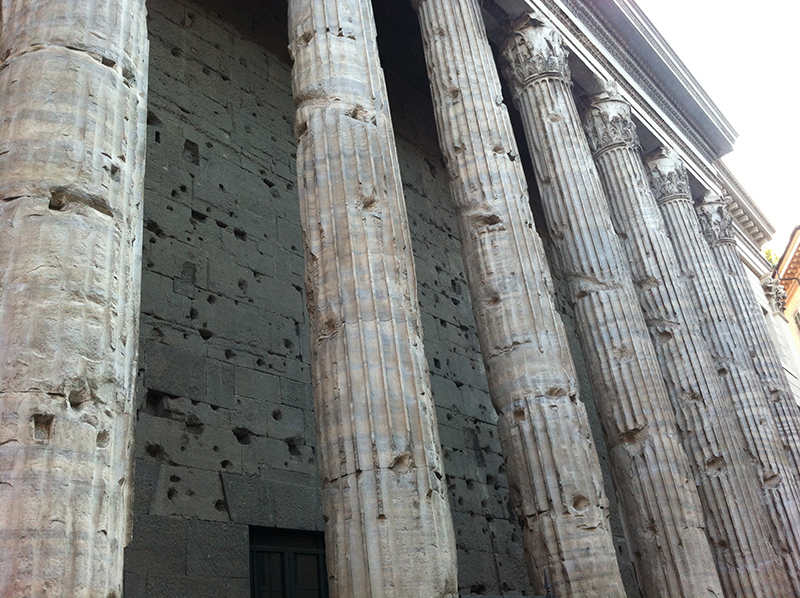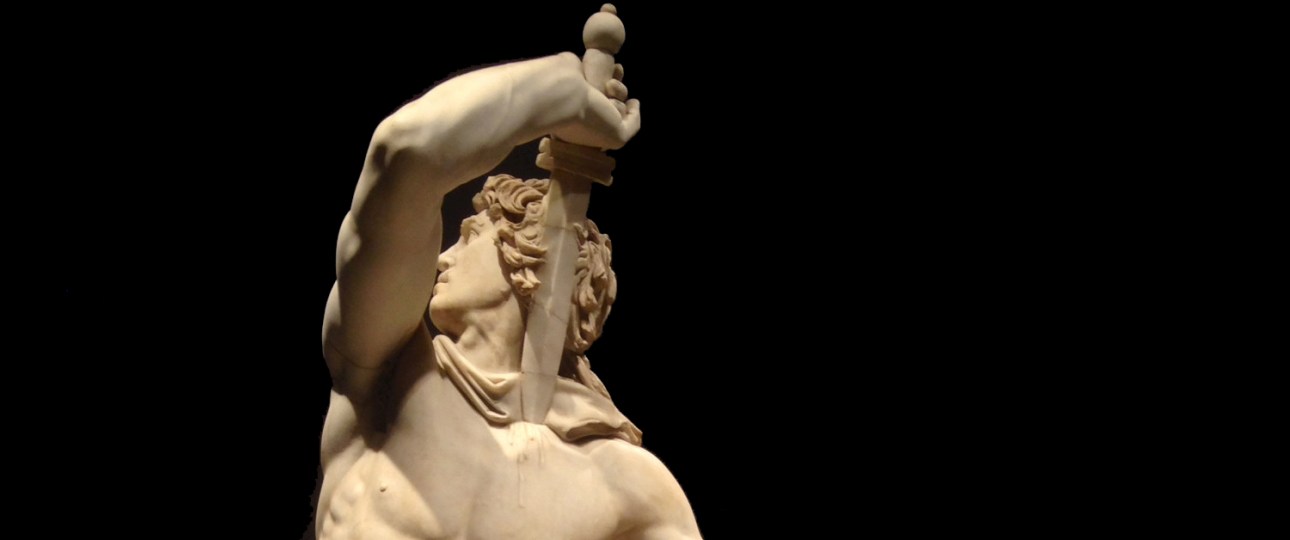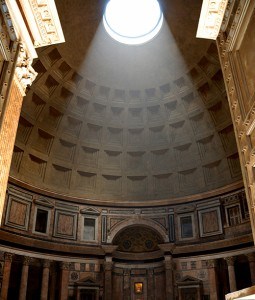
In the West, the design of temples and their impressive, decorative columns goes back to the ancient Egyptians. The technique will be codified by the Ancient Greeks. Vitruvius however, will get credit later on, as his book is the only surviving major work on the subject.
The Egyptians used sandstone, which is very easy to carve, and so they created many wonderful designs in their capitals. This is unusually creative for such an otherwise strictly disciplined culture.

The Greeks learned to ‘go big’ from the Egyptians, but their local stone is marble. Much more difficult to cut than sandstone, they created and codified their capitals to 3 basic types – Ionic, Doric and Corinthian.
Notice however, how both Egyptians and Greeks created columns by stacking smaller column parts on top of one another. These were probably reinforced with metal joints. The Egyptians created ‘half-barrels’ which they matched and joined together. Greeks and later Egyptians will improve by creating a ‘full-barrel’.
Columns could be tapered and are normally ‘fluted’ or grooved (columns for common buildings are plain). It is not until the Romans come along that these columns are created as one solid stalk.
What we are going to see today is how it is possible to date a Roman temple – by the type of column that was used!
Forum Holitorium Columns
 This is an area of Rome that few tourists venture into, unless it is to place their hand in the ‘Mouth of Truth’ (Bocca della Verità). This forum is probably the oldest part of Rome. Close to the river, it was the original center of trade and imports. Archeologists found clay vases dating back to the 9th century BC.
This is an area of Rome that few tourists venture into, unless it is to place their hand in the ‘Mouth of Truth’ (Bocca della Verità). This forum is probably the oldest part of Rome. Close to the river, it was the original center of trade and imports. Archeologists found clay vases dating back to the 9th century BC.
Here, we see the the remains of three temples placed next to each other, where is now located the church of St. Nicola in Chains. These temples, to Spes (Hope), Juno Sospita (where the church is located) and Janus were all originally built around 200BC.

Two of the them (Juno and Janus) use peperino columns. This is a volcanic rock that they covered in white plaster – to make the columns look like marble. These also, are not one solid column, but merely pieces placed on top of one another.
The temple to Spes had columns made of travertine, which is the local limestone that will gain so much popularity later on.
Largo Argentina Columns


The columns in this photo were for the temple to ‘Huiusce dei’ – god of the present day. This temple is dated to the year 101BC.
Mad of another volcanic rock, tuff, and we can see that they were also originally covered in white plaster.
According to Velleius Paterculus, the first man to build a temple in Rome in marble was Hermodorus of Salamis (a Greek). He built the temple to Jupiter at the Portico Ottavia in 146BC (Jewish Ghetto, no longer visible). The first temple in marble still visible is dedicated to Hercules and is located in the Forum Boarium. The architect here was the same Hermodorus of Salamis, and is dated to around 120BC.
As we can see, the columns created for Roman temples during the Republican period are made of some type of volcanic rock, cut into barrels stacked on one another, and then covered with plaster. These will be made by Roman architects. The change from tuff to marble begins in the 2nd century BC and continues with Julius Caesar in the 1st century BC. The emphasis on marble takes off with Octavian Augustus who declared that he “came to a city of brick and made a city of marble”.
Columns on the Temple to Apollo


This is best illustrated in our 3rd example, a temple dedicated to Apollo, which has some uniquely fluted columns. From 34BC, we don’t have any columns carved like this anywhere else in Rome. Look carefully at the impressive combination of wide and narrow grooves that are perfectly measured in the columns. We can also notice that it is one solid stalk of marble –
The Roman improvement, which may have begun with the Temple to Venus Genetrix in the forum for Julius Caesar! From this time, columns will no longer be made from parts, but will be brought from Greece or Turkey as one solid piece.
Roman columns for temples from this point on will be of fluted marble.
Until the Emperor Hadrian.
The Emperor Hadrian is the most architecturally visible Roman emperor. More stuff remains for him or by him than any other emperor. One of the most fantastic architectural achievements completed during his reign is the Pantheon.

All professionals in this field are obligated to state that we don’t know officially who was the architect for the Pantheon. I personally am becoming more and more convinced that it was the emperor himself (see my other article on The Pantheon).
From the time of the emperor Hadrian, Rome will no longer use fluted marble columns, but massively large columns. The columns we saw previously were narrow enough for a grown to wrap his arms almost entirely around the center stalk. These granite columns are about five feet in diameter.
These columns are estimated to weigh between 50 and 56 tons each. Hadrian could well have been influenced by the temples he saw in Egypt and Greece, but more importantly, he needed these massive columns to support the wall of the Pantheon, which is carrying the weight of the concrete dome.
Varying Columns in the Roman Forum

This is the temple to Faustina in the Roman Forum, wife of the emperor Antoninus Pius, who reigned immediately after Hadrian. Most guides will expound on how the marble columns are called ‘cipolina’ or ‘cipolla’ (onion) marble, because the lines in the stone reminded someone of the onion … blah, blah, blah.
Antoninus should have used fluted marble columns, especially for a temple to a woman (the temple is later rededicated to both husband and wife). However, Hadrian has set a new standard, and it will remain.

This photo I think most perfectly sums up the change from classical to Roman. The temple on the left is dedicated to Saturn. This edition is from the 4th century – Julian the Apostate rebuilt the temple – massive, granite columns. To the right, we see the remains of another temple with fluted marble columns, and so we know that this temple was built before Hadrian.
It is in fact, a temple honoring the emperor Vespasian as a god.
Now, here’s the enigma – this next temple honors the emperor Hadrian – completed in the year 140:
Temple Dedicated to the Emperor Hadrian

His temple, created by his successor, Antoninus, has not only fluted marble columns – but they are not the solid stalk we have become so familiar with in Rome. The architect has resorted to the traditional Greek method of creating the columns from sections and stacking them!
Hadrian, was known for loving ‘all things Greek’ (he was the first Roman emperor to have a beard, as he thought it made him look more like a Greek god). He was granted the honor of a temple done in the manner of the ancient Greeks!


